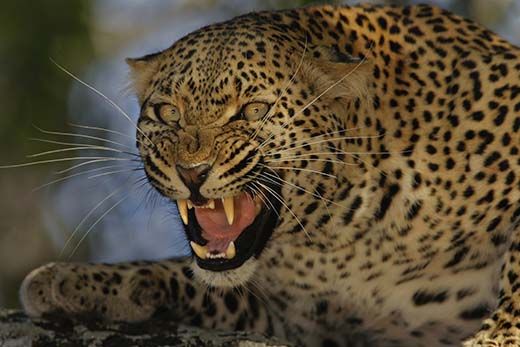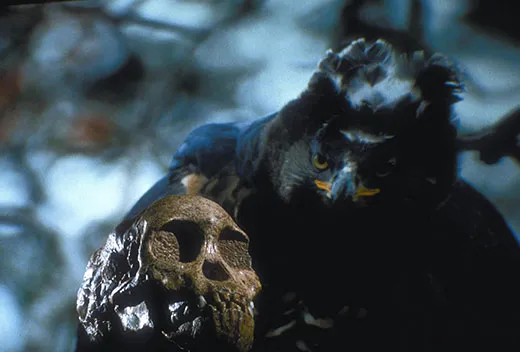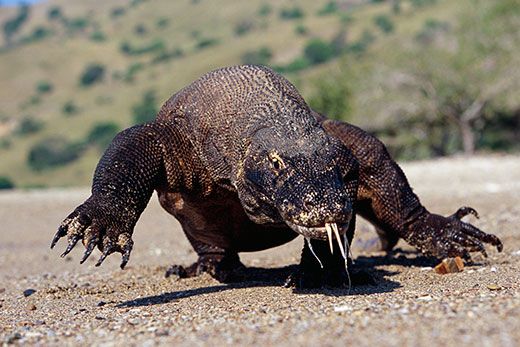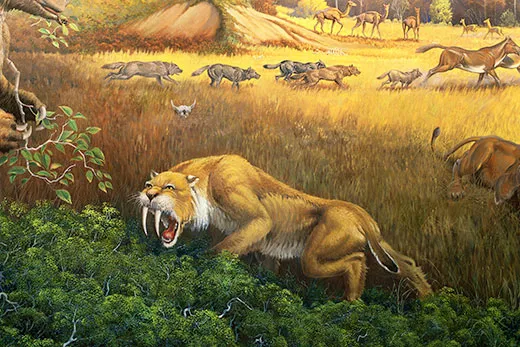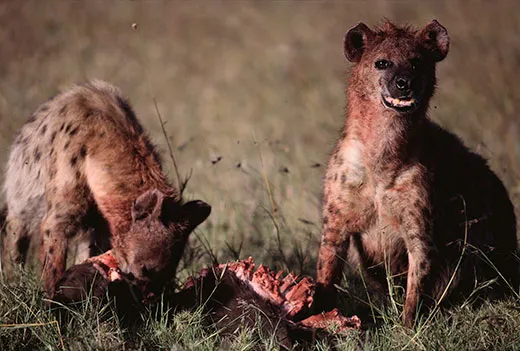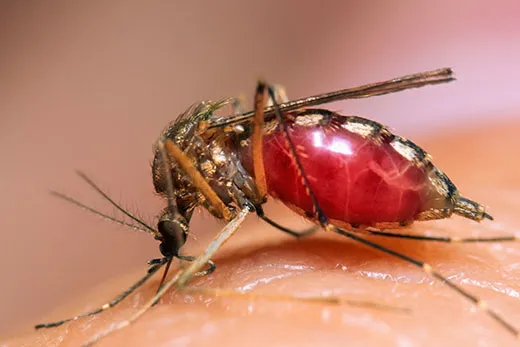The Top Ten Deadliest Animals of Our Evolutionary Past
Humans may be near the top of the food chain now, but who were our ancestors’ biggest predators?
/https://tf-cmsv2-smithsonianmag-media.s3.amazonaws.com/filer/predators-Taung-skull-African-crowned-eagle-631.jpg)
If you live in a developed country, odds are you are going to die of a heart attack, stroke, cancer or an accident. But it was not always this way. For most of our evolutionary history as primates, one of the most common causes of death, perhaps the most common cause, was, well, being eaten.
Starting with the first primates, which evolved about 65 million years ago, our ancestors were about the size of a monkey, if not smaller. Larger apes evolved about 13 million years ago, eventually producing today’s gorillas, chimpanzees, orangutans, bonobos and us. Hominids, including our direct ancestors, split from chimps and bonobos about seven million years ago, and our own species, Homo sapiens, is only about 200,000 years old. Evidence of our historic fates comes from knowing what eats monkeys or apes today, and from studying what ate now-extinct species. For example, many of the best fossils of hominids come from piles of bones near places where predators ate lunch.
Here then are ten of the animals likely to have killed our ancient and not so ancient kin. The fact that you are alive means your direct ancestors escaped these fates, if not forever then at least long enough to reproduce.
1. Lions and tigers and leopards, oh #$*@!
Leopards are extraordinarily good at eating primates. They are stealthy. They run fast (at least faster than our ancestors). They leap powerfully (up into primates’ sleeping trees). And they can carry great weights (our bodies) to wherever it might be safe for them to pause and dine. With this combination of traits, leopards have been breathing down our necks for as long as 10 million years.
Today’s leopards show what our ancestors had to contend with. In one study in South Africa’s Kruger National Park, 70 percent of baboon deaths were attributed to African leopards. In another study, half of the mammals that leopards killed were monkeys or chimpanzees; they also kill young gorillas. When scientists pick through leopard scat, many of the bones they find are from primates—ribs, fingers, toes and skulls, all of them remarkably similar to our own skeleton. Baboons seem to get eaten by leopards at night, monkeys during the day. Scientists, on the other hand, are most likely to get eaten when they pause while picking through leopard scat to say, “Hey, I think this looks fresh!”
Primates, including humans, are also eaten by lions in Africa, tigers in the Asian tropics, and cougars and jaguars in the Americas. A single troop of chimpanzees in Tanzania had four of its members eaten by lions in just a few days in 1989. The authors of that study reported, a bit somberly, that the “responses of chimpanzees to lions included alarm calls, whimpers, climbing into trees, and silence.” We have no reason to believe our ancestors’ responses were any different.
2. The first humans to fly
I tease my neighbor because she worries about red-tailed hawks carrying off her small dog, but the truth is that not so long ago, eagles would have carried off our small children. One of the most famous hominid fossils is the skull of a 3-year-old child found in Taung, South Africa. The Taung child was a member of the Australopithecus africanus species, which lived in Africa from about three million to two million years ago. The skull has holes neatly punched into its eye sockets; they were made by the talons of a large bird akin to an African crowned eagle. The skull was found among other bones under what has been interpreted as a nest. More recently, great piles of roughly five-million-year-old fossil monkey skulls, many of them with talon holes, were discovered in Angola under what appear to have been four separate eagle nests.
Today, 90 percent or more of the prey of crowned eagles in Kibale National Park in Uganda are primates, mostly cercopithecoid monkeys. Primates are also the favorite prey of harpy eagles in the tropical forests of the Americas. Perhaps the clearest indication of just how important predation, and predation by birds in particular, is in primate evolution comes from the lexicon of monkeys. Monkeys have distinct calls for different predators. Those terms include, “cat,” “snake” and, to paraphrase, “oh crap, eagle.” “Ohcrapeagle” may well have been one of the first human words.
3. Snakes
Snakes have long influenced our fate and evolution. In parts of Africa, venomous snakebites are common, and many of those bites prove deadly. Venomous snakes aren’t the only kind that kill humans and other primates today and might have killed our ancestors—constrictors can also do a fine job. New observations by Cornell University biologist Harry Greene even suggest that in some indigenous populations today, constricting snakes may be one of the most common causes of death.
4. A primate-eat-primate world
Anthropologists have argued, variously, that early hominids were aggressive hunters, peaceful foragers, hairless swimmers, sneaky scavengers and a dozen other things. Time may or may not tell. But some of our ancestors were almost certainly food for other primates. Today, some chimpanzees are, in effect, monkeyvores. In Uganda, chimps preferentially eat red colobus monkeys, which are said to taste like chicken. In other regions, chimps prefer black and white colobus monkeys. There is, as they say, no accounting for taste. Orangutans eat gibbons. Blue monkeys eat bush babies, squirrel-size nocturnal primates. Capuchin monkeys, those adorable organ grinders, eat owl monkeys and so on. Primates eat primates, and this has long been the case.
5. Dog days
There is a reason why the author of Little Red Riding Hood chose a wolf to put in Grandma’s bed. Wolves do occasionally kill humans, particularly in parts of Eastern Europe. Deaths seem to be more likely in the spring when mothers are hunting for food for their cubs. Data are sparse, but historic predation by wolves on young humans may once have been common—common enough to influence our stories and fears.
6. Nothing to laugh about
Spotted hyenas regularly prey on baboons and, in some regions, people. In the 1950s, hyenas ate 27 people in Malawi. But the real primate eaters are hyenas’ extinct relatives. As many as 100 hyena species have existed alongside primates. Many of those hyenas were big, mean brutes, including the short-faced hyena, Pachycrocuta, which was the size of a lion. It lived from three million to 500,000 years ago alongside the first hominids, such as Australopithecus, and more recent species in our lineage. It had a mouth capable of fully enveloping a hominid’s head, which it did. A treasure trove of skulls of “Peking man” (Homo erectus) found in China prior to World War II appears to have been from the waste pile of a Pachycrocuta.
7. Extinct monsters
Some of the most ferocious animals that once ate our kind are unlike any predators we contend with today. Even when they are reconstructed in museum exhibits, they appear more imaginary than real: giant hyenas, as mentioned, but also giant bears (Agriotherium), saber-toothed cats (Homotherium, Machairodus, Megantereon) and “false” saber-toothed cats (Dinofelis). In Australia, the first aboriginal colonists would have encountered giant, predatory kangaroos. Whether those roos proved deadly, we do not know. But imagine being chased by a giant hopping animal with six-inch-long teeth. Saber-toothed cats used their teeth to cut flesh, like pulling barbecue off a rib. In all likelihood, that flesh would have included that of our ancestors and kin, though the only evidence of their effects is from a single hominid skull bearing two holes, one for each saber.
8. Dragons, sharks and other local specialties
As Homo sapiens moved around the world, some of us ended up on lush islands with abundant fruit and no predators. Others ended up in the Komodo Islands, alongside Komodo dragons. These monitor lizards, weighing as much as 300 pounds, sometimes eat people, even today, especially tourists. Locals are said to have learned to avoid the monitors, but one imagines that this involved trial and—fatal—error. Many predators may have had big effects on human populations in specific regions, even if they did not affect our species’ fate more generally. For people who live near the sea, sharks have left their mark. In some regions, swimming is avoided for the simple reasons that swimmers get eaten. People in the Arctic are constantly on guard against polar bears. There were many different ways to be eaten by a predator, a true measure of earth’s biodiversity of claws and teeth.
9. In cold blood
Orangutan researchers Birute Galdikas and Carey Yeager were working in Indonesia when they observed a kind of crocodile in action. “At approximately 0730 h a false gavial shot from the water, grasped the macaque’s back, and, with the monkey in its jaws, resubmerged,” they wrote. “Some macaques vocalized immediately afterwards, and the victim’s nearest neighbor ran about 5 m away from the river edge.” This moment may have been a kind of reenactment of earlier such events, with slightly different protagonists (sometimes African crocodiles and humans, for example). Galdikas thinks that predation by gavials may account for a learned wariness of water among crab-eating macaques. Proboscis monkeys are also eaten by crocodilians.
Our ancestors had to worry about crocodilians, too. A new species of extinct crocodile was recently found in Kenya’s Olduvai Gorge, where many hominid fossils have been collected. It was named Crocodylus anthropophagus. “Anthropophagus” means human- or hominid-eating, and it earned the name in part because skeletons of both Homo habilis and Australopithecus bosiei were discovered not far from the crocodile bones. The skeletons bear the marks of what appear to be crocodile teeth and are missing their left feet.
10. The deadly now
The species listed so far were some of the most likely agents of our demise during our distant evolutionary history. As human populations grew and developed new technologies, predators became more rare because we killed them or ate their other prey. Eventually, a new “most deadly animal” emerged: the mosquito. Malaria, yellow fever and dengue, among other mosquito-borne diseases, evolved with agriculture and the expansion of civilization. Billions of humans have died because of mosquitoes, influencing our genes and even our behavior.
Even where we have beaten back our ancestral predators, we bear their mark. Our brains are wired for fight and flight because of predators. We are anxious. We readily fear what used to threaten us, such as snakes. We are who we were, but more so than that, we are what we wanted to escape. Our first words may have been uttered to warn our family of cats, snakes or eagles. Even our screams, those wordless sounds we make when we are afraid, are an echo of the ghosts of our pasts. Whether we notice or not, our bodies remember those days in which the wolf in Grandma’s bed may really have been a wolf; they remember the species we ran from, screaming as we tried to flee.
Rob Dunn is a biologist at North Carolina State University. His new book, The Wild Life of Our Bodies, is being published this week. It tells the stories of our changing relationships with other species (be they worms, bacteria or tigers). In doing so, it considers questions such as what our appendix does, why we suffer anxiety, why human babies tend to be born at night and whether tapeworms are good for us, all from an ecological perspective.
